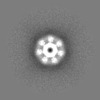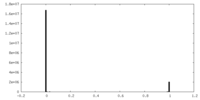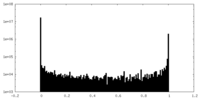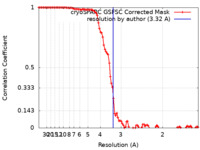+ Open data
Open data
- Basic information
Basic information
| Entry |  | |||||||||
|---|---|---|---|---|---|---|---|---|---|---|
| Title | Recombinant Ena3A L-Type endospore appendages | |||||||||
 Map data Map data | ||||||||||
 Sample Sample |
| |||||||||
 Keywords Keywords | Endospore / Pili / Protein / Fiber / Spore / Appendage / Bacillus paranthracis / PROTEIN FIBRIL / recombinant | |||||||||
| Function / homology | Endospore appendages core / Endospore appendages / Endospore appendages core domain-containing protein Function and homology information Function and homology information | |||||||||
| Biological species |  | |||||||||
| Method | helical reconstruction / cryo EM / Resolution: 3.32 Å | |||||||||
 Authors Authors | Sleutel M / Remaut H | |||||||||
| Funding support |  Belgium, 1 items Belgium, 1 items
| |||||||||
 Citation Citation |  Journal: Nat Commun / Year: 2024 Journal: Nat Commun / Year: 2024Title: Helical ultrastructure of the L-ENA spore aggregation factor of a Bacillus paranthracis foodborne outbreak strain. Authors: Mike Sleutel / Ephrem Debebe Zegeye / Ann-Katrin Llarena / Brajabandhu Pradhan / Marcus Fislage / Kristin O'Sullivan / Nani Van Gerven / Marina Aspholm / Han Remaut /   Abstract: In pathogenic Bacillota, spores can form an infectious particle and can take up a central role in the environmental persistence and dissemination of disease. A poorly understood aspect of spore- ...In pathogenic Bacillota, spores can form an infectious particle and can take up a central role in the environmental persistence and dissemination of disease. A poorly understood aspect of spore-mediated infection is the fibrous structures or 'endospore appendages' (ENAs) that have been seen to decorate the spores of pathogenic Bacilli and Clostridia. Current methodological approaches are opening a window on these long enigmatic structures. Using cryoID, Alphafold modelling and genetic approaches we identify a sub-class of robust ENAs in a Bacillus paranthracis foodborne outbreak strain. We demonstrate that L-ENA are encoded by a rare three-gene cluster (ena3) that contains all components for the self-assembly of ladder-like protein nanofibers of stacked heptameric rings, their anchoring to the exosporium, and their termination in a trimeric 'ruffle' made of a complement C1Q-like BclA paralogue. The role of ENA fibers in spore-spore interaction and the distribution of L-ENA operon as mobile genetic elements in B. cereus s.l. strains suggest that L-ENA fibers may increase the survival, spread and virulence of these strains. #1:  Journal: Biorxiv / Year: 2023 Journal: Biorxiv / Year: 2023Title: A novel class of ultra-stable endospore appendages decorated with collagen-like tip fibrillae Authors: Sleutel M / Zegeye ED / Llarena AK / Pradhan B / Fislage M / O'Sullivan K / Aspholm M / Remaut H | |||||||||
| History |
|
- Structure visualization
Structure visualization
| Supplemental images |
|---|
- Downloads & links
Downloads & links
-EMDB archive
| Map data |  emd_17627.map.gz emd_17627.map.gz | 50.5 MB |  EMDB map data format EMDB map data format | |
|---|---|---|---|---|
| Header (meta data) |  emd-17627-v30.xml emd-17627-v30.xml emd-17627.xml emd-17627.xml | 19.2 KB 19.2 KB | Display Display |  EMDB header EMDB header |
| FSC (resolution estimation) |  emd_17627_fsc.xml emd_17627_fsc.xml | 9.9 KB | Display |  FSC data file FSC data file |
| Images |  emd_17627.png emd_17627.png | 71.8 KB | ||
| Masks |  emd_17627_msk_1.map emd_17627_msk_1.map | 103 MB |  Mask map Mask map | |
| Filedesc metadata |  emd-17627.cif.gz emd-17627.cif.gz | 6.4 KB | ||
| Others |  emd_17627_half_map_1.map.gz emd_17627_half_map_1.map.gz emd_17627_half_map_2.map.gz emd_17627_half_map_2.map.gz | 95.6 MB 95.6 MB | ||
| Archive directory |  http://ftp.pdbj.org/pub/emdb/structures/EMD-17627 http://ftp.pdbj.org/pub/emdb/structures/EMD-17627 ftp://ftp.pdbj.org/pub/emdb/structures/EMD-17627 ftp://ftp.pdbj.org/pub/emdb/structures/EMD-17627 | HTTPS FTP |
-Validation report
| Summary document |  emd_17627_validation.pdf.gz emd_17627_validation.pdf.gz | 952.8 KB | Display |  EMDB validaton report EMDB validaton report |
|---|---|---|---|---|
| Full document |  emd_17627_full_validation.pdf.gz emd_17627_full_validation.pdf.gz | 952.4 KB | Display | |
| Data in XML |  emd_17627_validation.xml.gz emd_17627_validation.xml.gz | 18.4 KB | Display | |
| Data in CIF |  emd_17627_validation.cif.gz emd_17627_validation.cif.gz | 23.9 KB | Display | |
| Arichive directory |  https://ftp.pdbj.org/pub/emdb/validation_reports/EMD-17627 https://ftp.pdbj.org/pub/emdb/validation_reports/EMD-17627 ftp://ftp.pdbj.org/pub/emdb/validation_reports/EMD-17627 ftp://ftp.pdbj.org/pub/emdb/validation_reports/EMD-17627 | HTTPS FTP |
-Related structure data
| Related structure data | 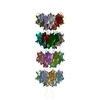 8pdzMC M: atomic model generated by this map C: citing same article ( |
|---|---|
| Similar structure data | Similarity search - Function & homology  F&H Search F&H Search |
- Links
Links
| EMDB pages |  EMDB (EBI/PDBe) / EMDB (EBI/PDBe) /  EMDataResource EMDataResource |
|---|
- Map
Map
| File |  Download / File: emd_17627.map.gz / Format: CCP4 / Size: 103 MB / Type: IMAGE STORED AS FLOATING POINT NUMBER (4 BYTES) Download / File: emd_17627.map.gz / Format: CCP4 / Size: 103 MB / Type: IMAGE STORED AS FLOATING POINT NUMBER (4 BYTES) | ||||||||||||||||||||||||||||||||||||
|---|---|---|---|---|---|---|---|---|---|---|---|---|---|---|---|---|---|---|---|---|---|---|---|---|---|---|---|---|---|---|---|---|---|---|---|---|---|
| Projections & slices | Image control
Images are generated by Spider. | ||||||||||||||||||||||||||||||||||||
| Voxel size | X=Y=Z: 0.764 Å | ||||||||||||||||||||||||||||||||||||
| Density |
| ||||||||||||||||||||||||||||||||||||
| Symmetry | Space group: 1 | ||||||||||||||||||||||||||||||||||||
| Details | EMDB XML:
|
-Supplemental data
-Mask #1
| File |  emd_17627_msk_1.map emd_17627_msk_1.map | ||||||||||||
|---|---|---|---|---|---|---|---|---|---|---|---|---|---|
| Projections & Slices |
| ||||||||||||
| Density Histograms |
-Half map: #2
| File | emd_17627_half_map_1.map | ||||||||||||
|---|---|---|---|---|---|---|---|---|---|---|---|---|---|
| Projections & Slices |
| ||||||||||||
| Density Histograms |
-Half map: #1
| File | emd_17627_half_map_2.map | ||||||||||||
|---|---|---|---|---|---|---|---|---|---|---|---|---|---|
| Projections & Slices |
| ||||||||||||
| Density Histograms |
- Sample components
Sample components
-Entire : Recombinant Ena3A L-type endospore appendage
| Entire | Name: Recombinant Ena3A L-type endospore appendage |
|---|---|
| Components |
|
-Supramolecule #1: Recombinant Ena3A L-type endospore appendage
| Supramolecule | Name: Recombinant Ena3A L-type endospore appendage / type: organelle_or_cellular_component / ID: 1 / Parent: 0 / Macromolecule list: all |
|---|---|
| Source (natural) | Organism:  |
| Molecular weight | Theoretical: 18.03 kDa/nm |
-Macromolecule #1: DUF3992 domain-containing protein
| Macromolecule | Name: DUF3992 domain-containing protein / type: protein_or_peptide / ID: 1 / Number of copies: 28 / Enantiomer: LEVO |
|---|---|
| Source (natural) | Organism:  |
| Molecular weight | Theoretical: 11.58715 KDa |
| Recombinant expression | Organism:  |
| Sequence | String: MAQIGNCCTE QLCCVNDAVC CTIILDDTGG TALPIWDDAT TFVINGTIMV ENNGTVGVGP TAALTVNGTA VGGFVVAPGE CRSITMNDI NSIAIVGAGT GTSSVKISFS INYKF UniProtKB: Endospore appendages core domain-containing protein |
-Experimental details
-Structure determination
| Method | cryo EM |
|---|---|
 Processing Processing | helical reconstruction |
| Aggregation state | filament |
- Sample preparation
Sample preparation
| Buffer | pH: 7 / Component - Formula: miliQ |
|---|---|
| Vitrification | Cryogen name: ETHANE |
- Electron microscopy
Electron microscopy
| Microscope | JEOL CRYO ARM 300 |
|---|---|
| Image recording | Film or detector model: GATAN K2 SUMMIT (4k x 4k) / Number real images: 8528 / Average electron dose: 62.5 e/Å2 |
| Electron beam | Acceleration voltage: 300 kV / Electron source:  FIELD EMISSION GUN FIELD EMISSION GUN |
| Electron optics | Illumination mode: SPOT SCAN / Imaging mode: BRIGHT FIELD / Nominal defocus max: 3.5 µm / Nominal defocus min: 0.5 µm / Nominal magnification: 60000 |
 Movie
Movie Controller
Controller



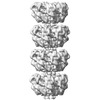

 Z (Sec.)
Z (Sec.) Y (Row.)
Y (Row.) X (Col.)
X (Col.)







